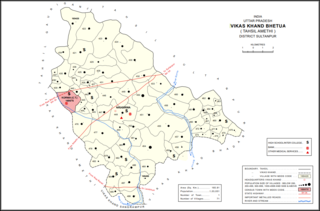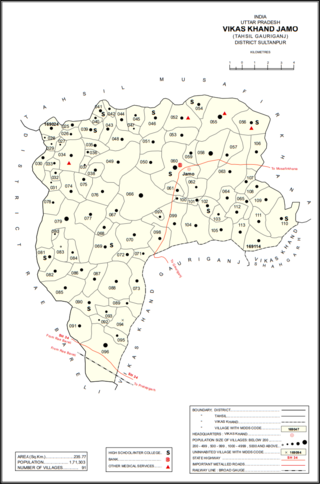
Gauriganj is a city, tehsil and administrative headquarters of Amethi district in Ayodhya division, Uttar Pradesh, India. It is situated about 126 km from Lucknow, the capital of Uttar Pradesh. It is located in Eastern Uttar Pradesh. Before July 2010, Gauriganj was part of Sultanpur district and then taking Gauriganj, Amethi, Jais, Jagdispur and Salon, formed a new district called Chatrapati Sahuji Maharaj Nagar, later named Gauriganj and now Amethi. Gauriganj is connected with State Highway 34 and National Highway 128.

Gairikpur is a village in Bhetua block of Amethi district in Uttar Pradesh, India. As of 2011, its population is 1,754 people, in 275 households. It has one primary school and no healthcare facilities and does not host a permanent market or weekly haat. It serves as the headquarters of a nyaya panchayat that also includes 15 other villages.

Paho, also spelled Pahu, is a village in Khiron block of Rae Bareli district, Uttar Pradesh, India. It is located near the road from Raebareli to Mauranwan and Unnao, close to the border with Unnao district. It is 18 km away from Lalganj, the tehsil headquarters. As of 2011, Paho has a population of 5,620 people, in 1,088 households. It has two primary schools and no healthcare facilities, and it hosts a weekly haat but not a permanent market. It is the seat of a nyaya panchayat which also includes 7 other villages.

Asura is a village in Gauriganj block of Amethi district, Uttar Pradesh, India. As of 2011, it has a population of 803 people, in 140 households. It has one primary school and no healthcare facilities and does not host a permanent market or weekly haat. It belongs to the nyaya panchayat of Semuai.

Bhawanshahpur is a village in Gauriganj block of Amethi district, Uttar Pradesh, India. As of 2011, it has a population of 821 people, in 154 households. It has no schools and no healthcare facilities and does not host a permanent market or weekly haat. It belongs to the nyaya panchayat of Semuai.

Dhanapur is a village in Gauriganj block of Amethi district, Uttar Pradesh, India. As of 2011, it has a population of 953 people, in 159 households. It has one primary school and no healthcare facilities and does not host a permanent market or weekly haat. It belongs to the nyaya panchayat of Semuai.

Biswan is a village in Gauriganj block of Amethi district, Uttar Pradesh, India. As of 2011, it has a population of 353 people, in 55 households. It has no schools and no healthcare facilities and hosts both a permanent market and a weekly haat. It belongs to the nyaya panchayat of Semuai.

Dharupur is a village in Gauriganj block of Amethi district, Uttar Pradesh, India. As of 2011, it has a population of 1,112 people, in 169 households. It has one primary school and no healthcare facilities and does not host a permanent market or weekly haat. It belongs to the nyaya panchayat of Semuai.

Jagmalpur is a village in Gauriganj block of Amethi district, Uttar Pradesh, India. As of 2011, it has a population of 520 people, in 80 households. It has two primary schools and no healthcare facilities and does not host a permanent market or weekly haat. It belongs to the nyaya panchayat of Semuai.

Pachehri is a village in Gauriganj block of Amethi district, Uttar Pradesh, India. As of 2011, it has a population of 1,403 people, in 263 households. It has one primary school and no healthcare facilities and does not host a permanent market or weekly haat. It belongs to the nyaya panchayat of Bahanpur.

Raghipur is a village in Gauriganj block of Amethi district, Uttar Pradesh, India. As of 2011, it has a population of 1,207 people, in 231 households. It has one primary school and no healthcare facilities and hosts a permanent market but not a weekly haat. It belongs to the nyaya panchayat of Bahanpur.

Barna Tikar is a village in Gauriganj block of Amethi district, Uttar Pradesh, India. As of 2011, it has a population of 2,927 people, in 531 households. It has one primary school and no healthcare facilities and hosts both a permanent market and a weekly haat. It belongs to the nyaya panchayat of Katra Lalganj.

Jamo, also spelled Jamun or Jamon, is a village and community development block headquarters in Gauriganj tehsil of Amethi district, Uttar Pradesh, India. As of 2011, it has a population of 6,734 people, in 1,182 households. It was historically the capital of the pargana of Gaura Jamun. It is located at the intersection of four minor district roads, some of which are prone to flooding during the rainy season.

Gaura is a village in Jamo block of Amethi district, Uttar Pradesh, India. The namesake of the historical pargana of Gaura Jamun, Gaura consists of a main site called Gaura khas in the northeast surrounded by several smaller hamlets. The village lands are fertile and contain many orchard groves. In the east-central part there is a large jhil which provides a convenient source of irrigation but also sometimes overflows and floods the surrounding fields. Gaura is located just north of Jamo on the Gauriganj-Jagdishpur road, and another road also leads off to Musafirkhana.

Katari is a village in Jamo block of Amethi district, Uttar Pradesh, India. It is located by a stream called the Naiya or Kandu nala, which flows east toward the Gomti river. The main highway from Lucknow to Jaunpur passes further north. Katari was historically the seat of a taluqdari estate held by a leading branch of the Kanhpuria Rajputs.

Baraulia is a village in Jamo block of Amethi district, Uttar Pradesh, India. As of 2011, it has a population of 3,878 people, in 691 households. It has one primary school and no healthcare facilities and it hosts both a regular market and a weekly haat. It belongs to the nyaya panchayat of Hardo.

Bakhshgarh is a village in Jamo block of Amethi district, Uttar Pradesh, India. As of 2011, it has a population of 1,628 people, in 275 households. It has one primary school and no healthcare facilities and it does not host a weekly haat or a permanent market. It belongs to the nyaya panchayat of Mawai.

Tikri is a village in Bhetua block of Amethi district, Uttar Pradesh, India. As of 2011, it has a population of 7,165 people, in 1,142 households. It has 3 primary schools and no healthcare facilities and does not host a weekly haat or permanent market. It belongs to the nyaya panchayat of Amey Maphi.

Naugirwa is a village in Bhetua block of Amethi district, Uttar Pradesh, India. As of 2011, it has a population of 1,168 people, in 220 households. It has one primary school and a veterinary hospital and hosts a weekly haat but not a permanent market. It belongs to the nyaya panchayat of Darai Mafi.
Kohra is a village in Amethi tehsil of Amethi district in the Indian state of Uttar Pradesh. Kohra was historically the seat of a large taluqdari estate held by a leading branch of the Bandhalgoti Rajputs. As of 2011, it has a population of 4,407 people, in 786 households.






